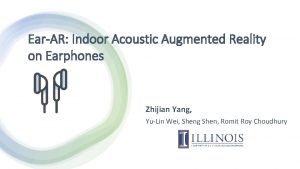Comparison of Insert and TDH SupraAural Earphones in

- Slides: 1

Comparison of Insert and TDH Supra-Aural Earphones in Identification of a 4000 -6000 Hz Notch Ishan Bhatt, Ph. D, CCC-A, FAAA Communication Sciences and Disorders, Northern Arizona University RESULTS BACKGROUND q Noise-induced hearing loss (NIHL) is defined as a bilateral audiometric hearing loss at the frequency range between 3000 to 6000 Hz with recovery at 8000 Hz. This audiometric “notch” configuration is considered a clinical signature of NIHL (Kirchner et al, 2012). q Literature indicates that studies which used supra-aural headphones for hearing threshold measurement revealed higher prevalence of audiometric notch (Niskar et al. , 2001, Phillips et al. , 2010, Bhatt & Guthrie, 2017) compared to a study which used insert headphones to measure hearing thresholds (Le Prell et al. , 2011). q The present study hypothesized that discrepancy in the prevalence of audiometric notch (4 -6 k. Hz) measured using supra-aural versus insert headphones can be explained by differences in sound pressure level generated by these headphones at the tympanic membrane (TM). AIMS OF THE STUDY 1. To compare the prevalence of audiometric notch between supra-aural headphone TDH-50 P (Telephonics Ltd. , Farmingdale, NY) and insert headphone ER-3 A (Etymotic Research. Inc, Elk Grove Village, IL). 2. To investigate relationship between: (1) noise exposure and notch and (2) threshold difference (ΔT) and difference in the real-ear sound pressure level (ΔRESPL) for the two types of headphones. A B Figure A: Comparison of hearing thresholds obtained by TDH-50 P and ER-3 A. Figure B: Comparison of RESPL generated by TDH-50 P and ER-3 A close to the TM. C METHODS q A sample of 49 subjects (i. e. 98 ears) aged 18 -30 years was collected. Subjects with normal otoscopy in both ears were included. Subjects with normal tympanograms (static compliance between 0. 35 to 1. 75 cc and peak pressure value between +50 to -100 da. Pa) in both ears were considered for testing. Audiometric Procedure q GSI-61 audiometer with TDH-50 P and ER-3 A headphones were used to obtain hearing thresholds. These headphones were calibrated using a standard procedure (ANSI S 3. 6 -2010). q RM 500 (Audio. Scan Ltd. , Dorchester, ON) was used to measure RESPL at the TM. This study utilized the acoustic method as described by Dirks et al (1996) to place probe microphone close to the TM. RESPL was measured at 1, 2, 3, 4, 6 and 8 k. Hz at the input level of 70 d. B SPL using THD-50 P. Audiometric thresholds were obtained at 1, 2, 3, 4, 6 & 8 k. Hz using the modified Hughson-Westlake procedure. The acoustic method was utilized to verify the probe placement and the procedure was repeat for ER-3 A. q ΔRESPL was calculated by subtracting RESPLER-3 A from RESPLTDH 50 P at each frequency. ΔT was measured by subtracting hearing threshold. ER-3 A from the hearing threshold. TDH-50 P. DISCUSSION q An audiometric notch at 4 -6 k. Hz which is often used to identify NIHL. The present study found that it is related to the configuration of RESPL generated by TDH-50 P headphones at the TM. q The results implied that the notch should not be used as the audiometric criterion for identifying NIHL especially when (1) supra-aural headphones are used to measure hearing thresholds and (2) notch depth is ≤ 15 d. B. Definition of Audiometric Notch q A drop in hearing sensitivity at 4 to 6 k. Hz of at least 15 d. B from the self-referenced previous best threshold in a linear progression of frequencies, with a recovery of at least 5 d. B after the notch (Phillips et al. , 2010). Acoustic exposure q Acoustic exposure was estimated via a self-report questionnaire developed by Megerson (2010). It assessed nine specific known areas of high acoustic exposure: occupational noise, power tools, heavy equipment, commercial sporting or entertainment events, motorized vehicles, small aircraft, music instrument playing, music listening via personal earphones, and music listening via audio speakers. Noise exposure is quantified in LAeq 8760 hrs. q The prevalence of an audiometric notch was around 30% when hearing thresholds were obtained using THD-50 P headphones. q The prevalence of the notch was around 2% when the hearing thresholds were obtained by ER-3 A headphones. q A chi square test revealed that the difference between the prevalence values was statistically significant (X 2 = 27. 9, p <10 -7) q Figure A presents hearing thresholds obtained using two transducers. The paired sample t-tests were run to identify statistically significant difference between the thresholds. The Bonferroni correction was applied to the significance value (p=0. 05/6=0. 0083) to accommodate for multiple comparisons. The analyses revealed that hearing thresholds were significantly different at each frequency. q Figure B presents RESPL values obtained by the probe microphone placed close to the TM. The paired sample t-tests were run to identify statistically significant differences between RESPL generated by two headphone types. The Bonferroni correction was applied to the significance value (p=0. 05/6=0. 0083) to accommodate for multiple comparisons. The analyses revealed that RESPL between transducers were significantly different at each frequency. q Figure C presents scatter plots between ΔRESPL and ΔT. The study obtained significant correlation at 1000 (r=-0. 305, p <0. 023), 2000 (r=0. 48, p = 0. 0002), 3000 (r=-0. 604, p = 0. 000001), 4000 (r=-0. 636, p < 107), 6000 (r=-0. 831, p < 10 -15) and 8000 Hz (r=-0. 725, p < 10 -10). q The Pearson correlation coefficient was not significant for noise exposure and notch (p > 0. 05). Major references Bhatt, I. S. , & Guthrie, O. N. (2017). Analysis of audiometric notch as a noise -induced hearing loss phenotype in US youth: data from the National Health And Nutrition Examination Survey, 2005– 2010. IJA, 1 -8 Le Prell et al. (2011). Evidence of hearing loss in a ‘normally-hearing ’college-student population. IJA, 50(sup 1), S 21 -S 31. Figure C: Scatter plots between ΔRESPL (RESPLTDH-50 P - RESPLER-3 A ) and ΔT (hearing threshold. TDH-50 P – hearing threshold. ER-3 A) at each audiometric frequency.

